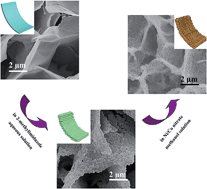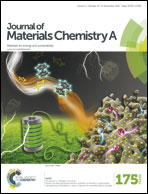An ordered ZIF-8-derived layered double hydroxide hollow nanoparticles-nanoflake array for high efficiency energy storage†
Abstract
A facile room-temperature synthesis of ZIF-8 nanoflakes using insoluble inorganic crystal zinc nitrate hydroxide nanoflakes as the Zn source has been demonstrated in this study for the first time. The transformation mechanism is discussed and investigated. It is found that apart from the acid–base affinity between zinc nitrate hydroxide and 2-methylimidazole, the specific layered crystal structure of zinc nitrate hydroxide is also responsible for the transformation kinetics. As a typical proof-of-concept application, the prepared ZIF-8 nanoflake array is subsequently used as a sacrificial template for constructing layered double hydroxides with extraordinary hollow nanoparticles-nanoflake architectures, in which each nanoflake comprises numerous hollow nanoparticles. Due to its unique structure, which facilitates effective ion and charge transfer without compromising the high surface area, the NiCo layered double hydroxide nanoflake array exhibits a very high capacity of 971.4 C g−1 at a current density of 1.9 A g−1, as well as excellent rate capability and durability. Furthermore, an assembled asymmetric supercapacitor integrated with commercial active carbon shows a high specific energy density of 52.1 W h kg−1 and a power density of 16.5 kW kg−1. The strategy proposed here gives significant insight into the synthesis of metal organic frameworks and provides a very important reference for the controllable design of MOF-based structures.



 Please wait while we load your content...
Please wait while we load your content...